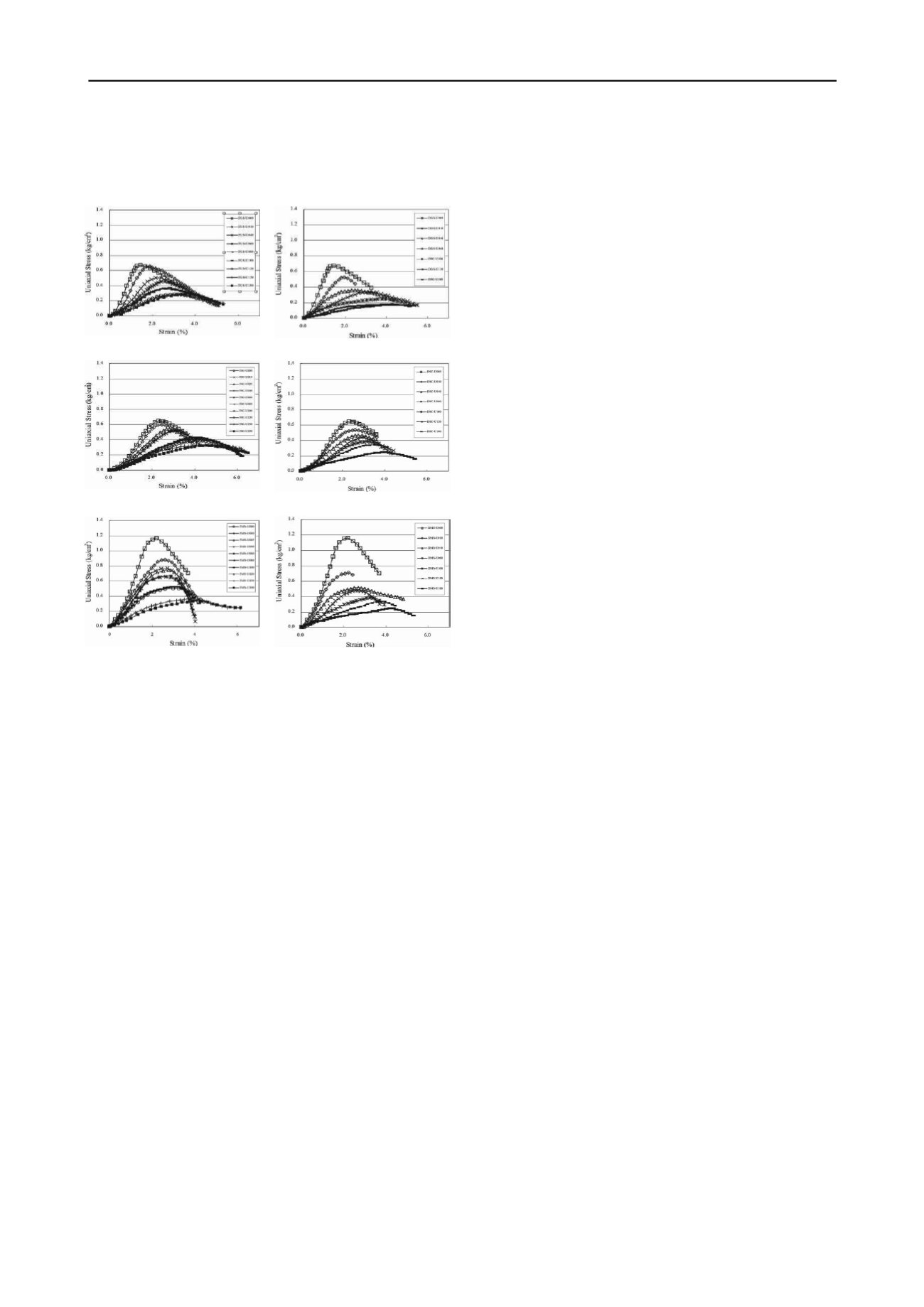
368
Proceedings of the 18
th
International Conference on Soil Mechanics and Geotechnical Engineering, Paris 2013
freezing state weakening its strength gradually. In addition, the
strength decrease by the drying and wetting repetition is caused
by the weakened binding power between soil particles.
The soil particles in the strength recovery and expansion area
of the soil in a dense state are oriented to show the maximum
contact area perpendicular to the maximum main stress
direction, so the expansion motion in a dense state is bigger than
that in a loose state and with a bigger initial tangent modulus.
Negative pressure in the freezing and thawing boundary is
the function of the gap size and on this point. the decrease of
gap water pressure increased the effective stress. At this point, if
a freezing starts, an ice nucleation is formed and a Cluster in
between soil particles and water is discharged from the Cluster
that the compression of the soil in the cluster is promoted by the
increased effective stress and dehydration. Once the thawing
starts, the cluster turns into a over consolidated state than the
original soil through the process of re-absorption as a thawing
water, leading to a collapse and weakening(Choi, 1996). From
this, we can learn that some structural change may have
occurred in the soil particles due to the freezing and thawing,
and that it is similar to the study result by Kim(2002) that for
the solid affected by the freezing and thawing, soil structure and
physical and chemical properties change without increases of
water content by weight.
4 CONCLUSIONS
For the characteristics of weathering soil, there should
always be limits to a minute access because of the particularity
of motion due to various weathering environment, weathering
degree and effect factors. Especially, the domestic and overseas
studies are focused on deposit soil and tend to analyze dynamic
motion of weathering soil from the aspect of deposit soil that it
is difficult to judge whether these results correspond to the real
motion of the weathering soil. Therefore, this study is to clarify
the characteristic change of igneous weathering soil by the
changes of temperature and water.
The strength change characteristics are identified by
promoting the weathering artificially through the freezing and
thawing and the drying and wetting processes.
After examining the effect of particle crushing by the
progress of weathering, it is identified that the particles become
finer through the freezing and thawing and the drying and
wetting processes. It is understood that the granulation by water
and temperature is caused by the granulation of quartz and
feldspar due to the change of grain sizes.
By measuring the outward specific gravity and examining
the change by weathering progress, it is understood that the
specific gravity of soil particles decreases as the repetition
numbers of the freezing and thawing and the drying and wetting
increase. The change of specific gravity appeared big in the
beginning of the repetition and decreasing as its number
increases. The specific gravity of the sample with the drying
and wetting repeated decreased bigger than that with the
freezing and thawing performed.
And when judging the effect factors of the weathering that
causes the change of specific gravity, it is judged that the
weathering by water rather than that by temperature has more
dominant effect on the specific gravity change.
In general, as the repetition number of freezing and thawing
increased, the compression stress of each sample decreased by a
similar ratio. Especially, the strength change in the beginning by
the freezing and thawing was significant.
However, the initial stress of each sample appeared different
while the compression stress during the 190 time repetitions has
a little difference. For the drying and wetting repetition, the
strength by the increase of repetition number continued to
decrease with a bigger change in the beginning than the overall
decreasing tendency. The uniaxial compression strength by the
change of weathering degree decreases similarly for all the
samples, but the axial deformation rate increases as the
repetition numbers of the freezing and thawing and the drying
and wetting increase.
It is very difficult to draw out the relation between testing
environment and real environment as well as the relation
between the weathering generated in the testing process and that
in the real environment, and to identify this fact from the mere
study result, so it is judged that a stored data and analysis for
various soil qualities would enable a quantitative distinction in
the weathering stage.
(a) Seoul
(a) Seoul
(b) Cheongdo
(b) Chenongdo
(c) Sabuk
(c) Sabuk
Figure 5. Uniaxial Compression
Test Result of Freezing and
Thawing Test Conditions
Figure 6. Uniaxial Compression
Test Result of Drying and
Wetting Test Conditions
5 REFERENCES
Aoyama, K., and Fucuda, M. 1990. Stress-Deformation characteristics
of a soil after freezing and thawing.
Proceedings of the ninth
Danube-European conference on soil Mechanics and Foundation
Engineering.
Budapest. October. 2-5. pp. 393-403
Matsuo, S., /Nisida, K. and Sasaki, S. 1979. Physical properties of
weathered Granite soil paticles and their effect on permeability.
soils and foundations
. Japanese Society of soil Mechanics and
foundation engineering. vol. 19, No.1, pp.13-22
S.Y. Choi. 1996. A study on the characteristics of the physical and
engineering properties of weathered soil of freezing and thawing.
Master Thesis, Kang-Won National Univ.
Yong, R. N., Boonsinsuk, P., and Yin, C. W. P. 1985. Alteration of soil
behavior after cycle freezing and thawing.
The 4th International
Symposium on Ground Freezing
. August. pp.187-195
Y.S. Kim. 2002. Development of the method to determine the
weathering degree of decomposed granites soil for the evaluation of
the engineering properties. Ph.D Thesis. Chung-Ang Univ.


